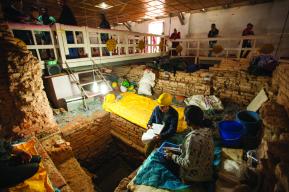
The heart of a community encapsulates its cherished history and aspirations. And in the dynamic community of Samchuk Market in Suphanburi Province, that beating heart is surely Baan Khun Jamnong Jeenarak. Built over a century ago, in 1916, this three-storey timber and concrete house, originally owned by a tax collector and landlord who governed the district, was restored and converted into a community museum in 2004, as part of the broader Samchuk Revitalization Project (1999–2006) initiated by the Chumchonthai Foundation in close consultation with members of the community. Three years after the project’s completion, its resounding success as a ‘holistic’ revitalization of a ‘historic commercial hub’ was recognized by UNESCO with an ‘Award of Merit’ as part of its 2009 Asia-Pacific Awards for Cultural Heritage Conservation.

Today, the Khun Jamnong Museum continues to nurture appreciation for local history and contribute meaningfully to the Samchuk Market community’s sense of pride. In addition, the museum lies at the heart of a new economy based not only upon Samchuk Market’s continued operation—a feat in itself—but now on cultural tourism as well. Upon entering the building, one’s attention is instantly drawn to an impressive scale model of the old market district. At a glance, the model affords a grasp of the market’s overall layout, in which over 150 two-storey timber shophouses line both sides of the four principal streets that lead to the Tha Chin River—the watery thoroughfare that was once the very ‘raison d’être’ for this historic commercial settlement.

For pedestrians swept up in the bustling energies of the market, this strategic layout may elude immediate comprehension, as culinary delights (such as roasted duck, rice wrapped in lotus leaf and Thai sponge cake), regional handcrafted mementos and assorted sundries all simultaneously vie for their attention. But in the relative calm of the Khun Jamnong Museum, the microcosmic eloquence of the scale model, taken together with the informative permanent displays, conveys the strong impression that, over the course of its long existence, the community’s evolution partook of larger social, cultural and economic forces that shaped the entire Samchuk District and beyond.

One could start with the Tha Chin river basin, which has been attracting human inhabitation with its rich fertility since prehistoric times. As is characteristic of the central plains of Thailand, paddy fields have been, and continue to be, a common sight in the region. Archaeological evidence suggests that the area now known officially as Samchuk District has been populated since the Dvaravati period (6th–11th centuries), and Mahayana Buddhist artefacts dating back to the 13th century have been unearthed at Nern Tang Pra, the district’s most important religious site.
Samchuk District began to experience significant population growth in the early Rattanakosin era (1782-1851), at that time spurred by the growing trade of rice and charcoal. In an age when waterways were the lifeblood of commerce, Samchuk Market prospered as a trading hub that intermingled people and cultural practices of diverse ethnicities, with Chinese merchants comprising the majority.

In Nirat Suphan, a collection of poetic verses recounting Sunthorn Phu’s (1786–1855) journey to Suphanburi in 1842 (apparently undertaken in a futile search for base metals to be transmuted into gold), the renowned early modern court poet evocatively characterized the moniker ‘Samchuk’ as being virtually synonymous in everyday parlance with numerous docked boats and the busy exchange of everyday goods.
Samchuk Market enjoyed its ‘golden age’ in the early decades of the 20th century. After the Second World War, however, the emergence of more modern markets and evolving modes of transportation that shifted from waterways to concrete highways—the ‘Malaiman Road’, or Highway 321, connecting Suphanburi to Bangkok via Nakhon Pathom especially—precipitated the market’s gradual decline. In 2006, the Treasury Department, which owns much of the land and properties in Samchuk, drafted plans to modernize the entire market area. This would have entailed the eviction of local residents and the destruction of the traditional shophouses. Catalyzed into action, the community came together and protested. In response to concerted community efforts, the Fine Arts Department designated the market area as a ‘Local Historic District’ in 2007, lending support to the grassroots-led revitalization of Samchuk Market. The Treasury Department relented, and joining hands with the community, a partnership was undertaken to make something more historic and sustainable of this revitalization than anyone had initially anticipated.

The 2009 citation by UNESCO in its Award of Merit for the ‘Samchuk Community and Old Market District’ underscored that ‘the community has been the main driving force for the [conservation] project at all levels, from setting policy to establishing urban design guidelines.’ As an example of technical achievement, one need only look back to the Khun Jamnong Museum itself. Here, the project’s conservation team meticulously documented construction details of what originated at the turn of the twentieth century as a private residence befitting a local official, including the building’s intricate ornamental subtleties (such as the silk-screened ceramic floor tiles) and the early application of the reinforced concrete and timber-frame construction method, to ensure that any restoration would honour both the material and aesthetic qualities of the place.
‘In contrast to World Heritage sites, which must satisfy the criteria of outstanding universal value, the UNESCO Asia-Pacific Awards for Cultural Heritage Conservation programme aims to recognize bottom-up conservation efforts initiated by the private sector or through public-private partnership,’ said Ms Montakarn Suvanatap Kittipaisalsilp, Associate Project Officer for Culture at UNESCO Bangkok. As demonstrated by the Samchuk Community and Old Market District, such efforts not only keep valued heritage meaningful and purposeful in modern contexts, but also augur well for the long-term sustainable development of local communities.
Noteworthy local conservation projects in the Asia-Pacific region are encouraged to apply for the UNESCO #HeritageAwards. Submissions are accepted until 31 July 2023. For more information, please visit: UNESCO Asia-Pacific Awards for Cultural Heritage Conservation project page
This is a lightly adapted version of an article that first appeared in the Bangkok Post on 5 July 2023.
#CultureForSustainableDevelopment
More from UNESCO Bangkok
Share
About the authors

Chairat Chongvattanakij is a Thai-Canadian consultant specializing in content creation for the Public Information and Outreach team at UNESCO Regional Office in Bangkok. He supports UNESCO in reporting, translation, media development and related projects in Asia and the Pacific.
In addition to his experience as a professional translator, Chairat is an accomplished pianist and music educator who holds a Doctor of Musical Arts degree from the University of Toronto, where he taught music theory and piano literature at the Faculty of Music. He has presented research papers at international academic conferences and delivered guest lectures and masterclasses at Mahidol University and Yamaha Music Academy Bangkok.








